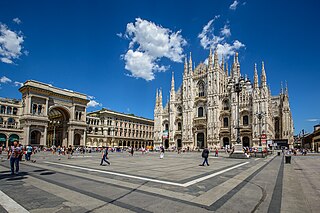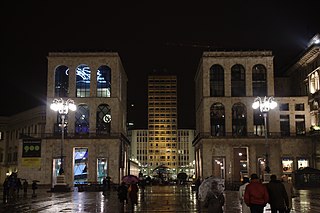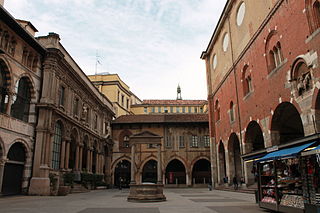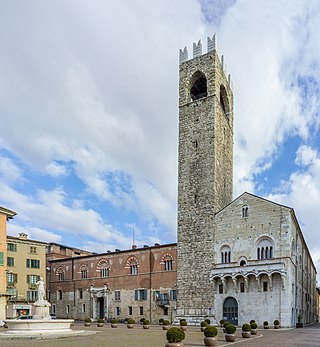
The Capitolium or Capitoline Hill, between the Forum and the Campus Martius, is one of the Seven Hills of Rome.

Piazza del Duomo is the main piazza of Milan, Italy. It is named after, and dominated by, Milan Cathedral. The piazza marks the center of the city, both in a geographic sense and because of its importance from an artistic, cultural, and social point of view. Rectangular in shape, with an overall area of 17,000 m2, the piazza includes some of the most important buildings of Milan, as well some of the most prestigious commercial activities, and it is by far the foremost tourist attraction of the city.

The Palazzo della Ragione is a medieval market hall, town hall and palace of justice building in Padua, in the Veneto region of Italy. The upper floor was dedicated to the town and justice administration; while the ground floor still hosts the historical covered market of the city. The palace separates the two market squares of Piazza delle Erbe from Piazza dei Frutti. It is popularly called "il Salone" . It is part of the UNESCO World Heritage Site of Padua's 14th-century fresco cycles.

The Capitoline Museums are a group of art and archaeological museums in Piazza del Campidoglio, on top of the Capitoline Hill in Rome, Italy. The historic seats of the museums are Palazzo dei Conservatori and Palazzo Nuovo, facing on the central trapezoidal piazza in a plan conceived by Michelangelo in 1536 and executed over a period of more than 400 years.

The Palazzo Venezia or Palazzo Barbo, formerly Palace of St. Mark, is a palazzo (palace) in central Rome, Italy, just north of the Capitoline Hill. The original structure of this great architectural complex consisted of a modest medieval house intended as the residence of the cardinals appointed to the church of San Marco. In 1469 it became a residential papal palace, having undergone a massive extension, and in 1564, Pope Pius IV, to win the sympathies of the Republic of Venice, gave the mansion to the Venetian embassy to Rome on the terms that part of the building would be kept as a residence for the cardinals, the Apartment Cibo, and that the republic would provide for the building's maintenance and future restoration. The palace faces Piazza Venezia and Via del Plebiscito. It currently houses the National Museum of the Palazzo Venezia.

Palazzo Borghese is a palace in Rome, Italy, the main seat of the Borghese family. It was nicknamed il Cembalo due to its unusual trapezoidal groundplan; its narrowest facade faces the River Tiber. The entrance at the opposite end of the building, the "keyboard" of the cembalo, faces onto the Fontanella di Borghese, with another in a great flanking facade to the Piazza Borghese that is extended by a slightly angled facade leading down Via Borghese towards the river. Both these entrances lead into a large courtyard on one side of which is a two level open arcade, with paired Doric and Ionic columns, that frames the garden beyond.

Piazza della Repubblica is a city square in Florence, Italy. It was originally the site of the city's forum; then of its old ghetto, which was swept away during the improvement works, or Risanamento, initiated during the brief period when Florence was the capital of a reunited Italy—work that also created the city's avenues and boulevards. At that time, the Loggia del Pesce from the Mercato Vecchio was also moved to Piazza Ciompi. The square's Giubbe Rosse cafe has long been a meeting place for famous artists and writers, notably those of Futurism.

Genova Piazza Principe railway station is the central station of Genoa and is located on Piazza Acquaverde, occupying the entire north side of Via Andrea Doria—where the station entrance is located—in the town centre and a short distance from the Palazzo del Principe, from which it takes its name. It is used by about 66,000 passengers per day and 24,000,000 per year. The first temporary station was opened in 1854 at the end of the line from Turin. Lines were later opened to Milan, Rome and the French border at Ventimiglia.

Piazza Cordusio is a square in central Milan, Italy. The piazza takes its name from the Cors Ducis which was located on the square during Longobard times. It is well known for its several turn-of-the-19th-century Neoclassical, eclectic and Art Nouveau buildings, banks and post offices. Even though many of these have now relocated elsewhere, it is still an important commercial square in the city and hosts the Palazzo delle Assicurazioni Generali, the Palazzo del Credito Italiano and the Palazzo delle Poste, former Borsa di Milano. Piazzale Cordusio hosts the Cordusio metro station and is the starting point of the elegant pedestrian Via Dante which leads to the imposing medieval Castello Sforzesco, or Milan Castle. Opposite to Via Dante, Cordusio borders onto Piazza Mercanti, former city centre in the Middle Ages, which leads directly to Piazza del Duomo, today's city centre.

Palazzo Aragona Gonzaga, also known as Palazzo Negroni, is a sixteenth-century palace in Rome, Italy. It was once the residence of Cardinal Scipione Gonzaga. During that time his cousin Luigi Gonzaga also lived there, as did the poet Torquato Tasso from 1587 to 1590. In the nineteenth century it belonged to the Galitzin family, and so is also known as Palazzo Galitzin.

The Palazzo dell'Arengario is a Fascist-era complex of two symmetrical buildings in Piazza del Duomo, the central piazza of Milan, Italy. It was completed in the 1950s and currently houses the Museo del Novecento, a museum dedicated to 20th-century art. The word "arengario" refers to its original function as a local government seat in the Fascist period.

The Palazzo della Ragione is a historic building of Milan, Italy, located in Piazza Mercanti, facing the Loggia degli Osii. It was built in the 13th century and originally served as a broletto as well as a judicial seat. As it was the second broletto to be built in Milan, it is also known as the Broletto Nuovo.

Piazza Mercanti is a central city square of Milan, Italy. It is located between Piazza del Duomo, which marks the centre of the modern city of Milan, and Piazza Cordusio, and it used to be the heart of the city in the Middle Ages. At the time, the square was larger than it is now and known as "Piazza del Broletto", after the "Broletto Nuovo", the palace that occupied the centre of the square. In the 13th century, there were six entry points to the square, each associated to a specific trade, from sword blacksmiths to hat makers.

Palazzo Della Rovere is a palace in Rome, Italy, facing Via della Conciliazione. It is also known as Palazzo dei Penitenzieri.

The Museo del Novecento is a museum of twentieth-century art in Milan, in Lombardy in northern Italy. It is housed in the Palazzo dell'Arengario, near Piazza del Duomo in the centre of the city.

Piazza d'Aracoeli is a square of Rome (Italy), placed at the base of the Capitoline Hill, in the Rione X Campitelli.

The Broletto or Broletto Palace of Brescia has for centuries housed the civic government offices of this city found in the region of Lombardy, Italy. The term Broletto refers to a buildings equivalent to the town hall or town assembly.

Palazzo dei Convertendi is a reconstructed Renaissance palace in Rome. It originally faced the Piazza Scossacavalli, but was demolished and rebuilt along the north side of Via della Conciliazione, the wide avenue constructed between 1936 and 1950, which links St Peter's Basilica and the Vatican City to the centre of Rome. The palace is famous as the last home of the painter Raphael, who died there in 1520.
The Palazzo del Podestà, or Palazzo del Broletto, is a 13th-century palace, located between Piazza delle Erbe and Piazza Broletto, in the center of Mantua, region of Lombardy, Italy. The building for many years serving as the offices of the Municipality. The main facade faces Piazza Broletto.

Borgo Vecchio, also named in the Middle Ages Via Sancta, Carriera Sancta or Carriera Martyrum, was a road in the city of Rome, Italy, important for historical and architectural reasons. The road was destroyed together with the adjacent quartier in 1936–37 due to the construction of Via della Conciliazione.























